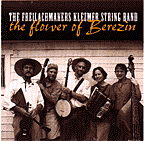The Freilachmakers Klezmer String Band / The Flower of Berezin

The Freilachmakers Klezmer String Band The Flower of Berezin
Tel: 916 484 1176 (USA)E-mail Freilachmakers Old-Time String Band
Web: www.freilachmakers.com
I was introduced to klezmer, really introduced (as opposed to being vaguely disinterested in Giora Feidman in the early '70s, and trying to like, but not being satisfied by the early "The Klezmorim" recordings), by a guy named Jeff Brody, in Santa Cruz. Although Jeff never claimed that klezmer and bluegrass fit together, his own mandolin-playing in the early revival band, Hotzeplotz, as much bluegrass mandolin as jazz hi-hat, was proof that the idea was plausible.
And that was about it for klezmer bluegrass. Sure, there was a lovely interlude in the Finjan CD, Crossing Selkirk Ave., and we all remembered that Andy Statman--one of Jeff's inspirations--was first a bluegrass and avant grade mandolinist before getting together with Zev Feldman and making history with "Jewish Klezmer Music, but it was Andy's clarinet playing that made it klezmer, not his mandolin."
All of which is a long, long prelude to the great music available on this first CD release from Sacramento's "Freilachmakers." From the opening lonely banjo picking of the soon-celebratory and full-band-supported "Heyser Bulgar", or the way "Papirosn" eventually drifts into "Ragtime" Annie, or the "Odessa Bulgar" that ends on a perfect Earl Scruggs note, to the closeing picking on "The Kishinever Bulgar," this is both a klezmer album and a bluegrass album. It's also a toe-tapping, swing your partner in a hora around the room pleasure.
This is such a fun album. From the bluegrass and Irish pieces, to the klezmer that infuses the entire album, to the lovely picking, this is true simkha music for those of us who have feet in European country dances as well as in the world of Jewish tradition. The fact that the pieces flow back and forth in national origin, and that one occasionally starts and goes to oneself, "oh, yeah, that's one of my favorite klezmer tunes, didn't Dave Grisman play it?" is proof that the melding is somehow both complete and still manages to represent all of the traditions rather than mushing them all into something unrecognizable and bland.
Nor is the album instrumental only. The occasional vocals, as on Andy Rubin's cover of "Shtil di Nacht" are done in perfect folk style. In this case, also appropriately evocative of the violence of the actions commemorated by the song (about the ambush of of a German supply truck by Jewish partisans during WWII).
This is the first klezmer album, and I include the relatively sterile Statman/Grisman collaboration on the list that I ponder as I say this, the first klezmer album, I say, that refers back and forth to all of these traditions as though they belong together, and proves that you can't keep a good dance down, regardless of its origin. For the mish mash of Eastern and Central European and Mediterranean traditions that make up klezmer as we knew it, the Freilachmakers have also extended the sense of "klezmer". I mean, here's what it comes down to. When you find yourself dancing, and on the side wondering ("was that beginning not bluegrass? no, I think it was klez. gee, it's great to dance!) then the band can fairly claim to be performing perfect simkha music, which is what you get here (even if you do notice the Celtic piping on the Irish dance that precedes the Medyatsiner Waltz, a Hasidic dance tune, brought to the notice of the modern klezmorim from The Klezmorim's "Streets of Gold" album.
I love this album. It is very special. It's California klezmer in the true spirit of Romania, Romania, yet, also, entirely California bluegrass, too. It is the essential klezmer bluegrass album. (Be honest--before listening to this, did you even know the category existed? How wonderful that it does!) Get a few for yourself. Give another few out to bluegrass and Irish music fans who haven't yet figured out the connection. They'll get it now.
Reviewed by Ari Davidow 8/7/99
Personnel, this recording
Elaine Fingerett: accordion
Dave Kidd: fiddle, balalaika, pennywhistle, voice (#2)
David Rosenfeld: guitar, mandolin (#1, 10)
Andy Rubin: 5-string (clawhammer) banjo, mandolin (#3, 8, 9), voice (#6)
Lou Ann Weiss: string bass
Songs
- Der Heyser Bulgar --The Hot Bulgar (Naftule Brandwein) 4:35
- Papirosn--cigarettes (Herman Yabloff)/Ragtime Annie (trad. USA) 6:54
- The Flowers of Antrim (Irish trad.) / The Flower of Berezin (Andy Rubin) 5:06
- Baym Rebn in Palestina--by the rebbe in Palestine (trad. klez) / Tantsl firn di Makhetonim—The In-Laws dance (trad., arr. FKSB) 6:01
- The Odessa Bulgar (trad., arr. FKSB) 4:00
- Shtil di Nacht--Still the Night (Hirsh Glik) 4:03
- Leibedik un Freilach--Lively and Happy (Abe Schwartz) 2:46
- Sonny's Mazurka (trad. Irish) / Horo (trad. Macedonian) 4:47
- The Medyatsiner Waltz (trad., Medyatsiner Hasid; from "The Klezmorim/Streets of Gold") / The Minsker Corporal's Waltz (Andy Rubin) 3:57
- Der Rebbe iz Gegangen (after Abe Elenkrig's Orchestra) / The Kishinever Bulgar (trad.) 8:38

